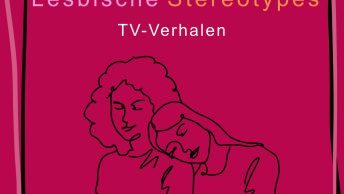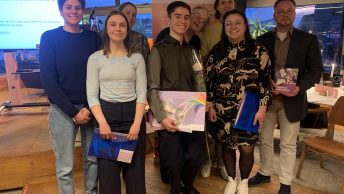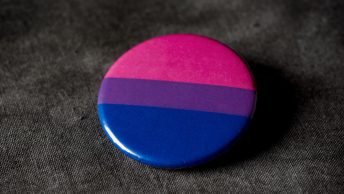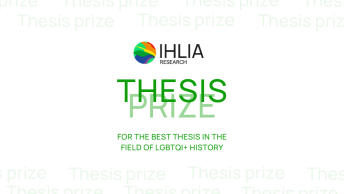
Op de website IHLIA Research schrijven wetenschappers en studenten regelmatig over lhbti-onderzoek. Lees hun bijdragen op ons blog.
Deze keer een bijdrage van Ninnoc Jikke. De blog is Engelstalig.
My name is Ninnoc, I am a history student at Utrecht University, specialising in the cultural history of queer and feminist movements. I completed my bachelor’s with a thesis on the emancipatory power of cultural expression within the Ballroom scene in New York. During my master’s, I have focused on feminist and queer communities in the Netherlands, exploring topics ranging from 17th-century gender benders to the experiences of queer individuals in Amsterdam’s House scene of the 1990s. From September to January, I interned at IHLIA, where I delved into LGBTQ+ archival materials and engaged with contemporary scholarship on queer movements in the Netherlands and beyond.
During my internship, I examined the dynamics of solidarity and separatism in the lesbian feminist movement in the 1970s and 1980s in the Netherlands. My sources were mainly (lesbian) feminist zines, newsletters and articles written by lesbian feminists. Although much
of the material originated from Amsterdam, I aimed to include perspectives from outside the capital, focusing on Nijmegen, Utrecht, and, surprisingly, Doetinchem.
Lesbian feminism is often described as a separatist movement, distancing itself from both the male-dominated gay emancipation movement and feminist spaces where lesbians were sometimes asked to hide their sexuality. However, recent scholarship has called for a re examination of these narratives, emphasising solidarity between gay and lesbian activists and other social movements. Inspired by this, I explored how lesbian feminist initiatives positioned themselves in relation to gay activists, heterosexual feminists, and other activist causes. My research comprised three chapters: lesbian archives, lesbian anarcha-feminism, and lesbians in feminist protests.
In my first chapter, I investigated the origins and development of lesbian archives, focusing on two: one in Amsterdam and one in Nijmegen. The impetus for creating lesbian archives mirrored the rationale for a separate lesbian feminist movement—lesbians were underrepresented in both gay and feminist movements, as well as their respective archives. The lesbian archive in Amsterdam, which opened in 1983, was housed in the basement of a private home where a group of lesbian women lived as a collective until 1990 when the archive was moved into a bigger space. It seems that men were not officially barred from entering the archive, but they were not necessarily welcome. According to one of the women who worked in the archive, they mostly had lesbian visitors. She stated: ‘Heterosexual women are clearly a minority. On a rare occasion a homosexual man visits. And the printer repairman but he doesn’t really count.’
The lesbian archive in Nijmegen (LAN) was housed in a bedroom until they were offered a space in Villa Lila, a new centre for the gay movement in Nijmegen, in 1985. However, the women of the LAN were adamant that no men would be allowed in their part of Villa Lila and
that they would not advertise for the COC. Seemingly, these lesbian archives mostly separated themselves from the gay emancipation movement and, perhaps less so, from the larger feminist movement. However, they were inclusive in other ways. For example, the LAN would only move into Villa Lila on the condition that their space be accessible to disabled women. They also included pieces written by disabled lesbians discussing the intersection of disability and queerness in their newsletters.
My second chapter was about the role of lesbians in the anarcha-feminist movement. Anarcha-feminists generally see the feminist struggle against patriarchal structures as a part of class conflict. Through my search for sources, I got into contact with someone who knew a lesbian anarcha-feminist from Doetinchem named Nanda Rutjes. They were able to tell me about Nanda’s activism and worldview and sent me some insightful newspaper clippings. Nanda and the activist group she was a part of concerned themselves with issues ranging from anarchism and anti-capitalism to nuclear energy and nuclear weapons, racism, fascism, gay and lesbian rights, feminism, housing, the environment, human rights, apartheid, anti militarism and art. Rather than viewing these as a set of separate but important issues, they were all seen as interconnected. They were all seen as symptoms of the same underlying problems, namely patriarchy, capitalism and power. In an interview with a local newspaper, Nanda said about herself: ‘In this consumer society, I protest against the violence of the male hetero-racism-culture by showing my power as a woman, by being a dyke, being jobless and being creative.’ Nanda politicised her lesbian identity not just as a strategy against heterosexism but as a strategy against all forms of power and discrimination. In my research, I found more examples of such intersectional activism by lesbian feminists, who demonstrated solidarity by advocating for systemic change for all marginalised groups.
My final chapter examined the participation of lesbians in feminist activism, focusing on abortion rights and anti-sexual violence protests. Lesbian feminists joined the 1981 women’s strike, which opposed a proposed law keeping abortion in the Criminal Code (as it remains today). For many feminists, their participation was unsurprising; although they were unlikely to need abortions themselves, they joined in solidarity. However, members of the group Lesbian Nation debated whether this issue truly concerned lesbians or was exclusively a heterosexual matter. Pamphlets distributed during the strike argued that abortion rights were integral to the fight against compulsory heterosexuality, as theorised by Adrienne Rich the year before. Patriarchal structures, they contended, restricted women’s choices, whether regarding abortion or loving other women. One pamphlet proclaimed:
On the face of it, dykes have no stake in the abortion law. So why join the strike? Because it is important for us dykes to stand in solidarity with the struggles of women emerging from oppression. Access to medically responsible abortion is the first, necessary step in the fight against compulsory heterosexuality.
This demonstrates how some lesbian feminists saw solidarity as self-evident while others engaged in deeper reflections on its implications. For this reason, lesbian feminist pamphlets were spread during the strike, which focused on the role of lesbians in the women’s movement and also emphasised the importance of lesbian visibility within the movement.
By looking at the dynamics of solidarity and separatism in the lesbian feminist movement, this research stepped away from dominant narratives of radical lesbian separatism to reveal a more complex story about the lesbian feminist movement in the Netherlands. It shows us how solidarity and separatism weren’t fixed positions but evolving strategies. And that’s where this history resonates with today. Movements now—whether they’re fighting for climate justice, racial equity, or LGBTQ+ rights—still wrestle with the same questions: How do we create spaces where marginalised voices can thrive? How do we balance the need for safe, exclusive spaces with the need to work across boundaries? The challenges faced by lesbian feminists navigating between separatism and solidarity are not relics of the past. Similar debates persist today, particularly within movements advocating for gender, racial, and economic justice. By revisiting these histories, we can better understand how to cultivate spaces that empower individuals while fostering collaboration across differences.







